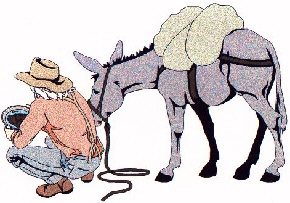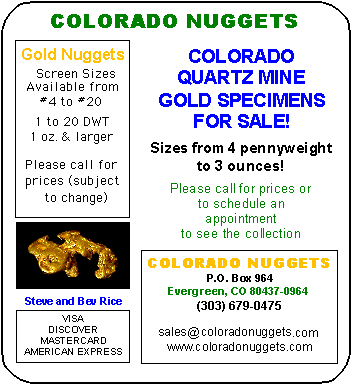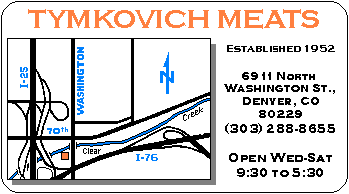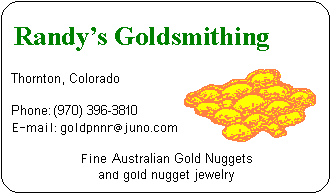 |
| Vol. 8, No. 5 | May 2003 | |
|
Lloyd G. Clements Community Center
7:00 PM (Board Meeting at 6:00 PM)
|
"Introduction"
by Hank Innerfeld
Dowsing is a natural and integral tool of man. It's history is as old as humanity itself. The phenomenon of dowsing has been accessible throughout the ages to individuals (both male and female) who chose to pursue and develop this innate aspect of self.
Every language spoken on planet Earth has at least one word to describe dowsing. The French called the dowser sourcier, or one who locates water sources. The Swiss called the dowser brunnenschoncher, or 'water seeker' and the dowsing dueten, meaning 'to point the stick'. The Danes' name for dowsing was finklerut, the Swedes', dalkarl. In Mexico, dowsers are called burros because the latter are also known for their ability to find water in the desert.
The early Chinese called dowsing 'talking to' or 'seeking' the "dragon flow" with the "claw of the dragon," or dowsing rod. Dowsing was also called fungshui or fing, meaning 'wind', and chi meaning 'water witching'. Similarly, here (in the United States) and abroad, dowsers have variously been called "water devils," "rod wielders," "doodle buggers," and "water diviners."
More modern labels for dowsers include motorscopists, psychoscopists, psychogenic water locators, psychometrist geomancers, radionics, and radiesthesics. Dowsing also has been called scanning and rhabdomancy, the latter derived from the Greek words rhabdos (rod) and manteia (prophet). In recent times, the phenomenon has come to be called dowsing almost universally. In the British army, those who practiced dowsing have come to be called "first-class well diggers."
The tools used by dowsers over the ages have variously been called Jacob's rods, divining rods, shining rods, leaping rods, trembling rods, rotating rods, dipping rods, transcending rods, superior rods, sticks, wands, forked sticks, pencils, L-rods, pendulums, motorscopes, and medicine sticks. Also used as dowsing tools have been scissors, Spanish needles, pliers, crowbars, shotguns, whale bones, barbed wire, clothes, welding rods, rings and other jewelry, feathers, candles (both lit and unlit), conch shells, medicine bones, aurameters, a Chinese diagram called "the Pakoua," and last but not least, fingers and hands!
"Historical Roots"
by Hank Innerfeld
In 1949, in the Atlas Mountains of North Africa, the French discovered cave paintings of ancient peoples. Scientists, using radiocarbon dated the paintings at 9,000 years old. One of these cave paintings showed a man using a dowsing rod. Similarly, a rock carving found in Peru, also dated 9,000 years old, depicts a man holding a forked dowsing stick.
The writings of Confucius (2500 B.C.) mention dowsing. A statue of Chinese Emperor Kwang Yu (2200 B.C.) portrays him holding a forked stick (commonly used for dowsing). Similarly, the oldest Egyptian stone drawings and carvings show men in exotic headdresses holding forked sticks or pendulums. The Romans, Celts, and Teutons also evidenced interest in dowsing. Various books produced in Germany from the 12th to 14th century examined the phenomenon of dowsing. During the reign of Queen Elizabeth (1558-1603), English landowners brought dowsers from Saxon Germany who obliged them by locating the rich tin fields of Cornwall, which are still producing tin today.
German scientist Georg Agricola, a pioneer in scientific classification of minerals, authored De re Metallica published in 1556. This classic work examines dowsing and its applications. Dowsers played a vital role in the construction of the early castles on the Rhine. Before the castles could be built, water had to be located beneath the stone mountain tops which they were to occupy. Dowsing was used universally to locate these underground water sources.
Visitors to the early Spanish mines in the Southwestern United States can observe that each mine features only one hole instead of many. The reason for that is, that prior to drilling, the Spanish used a dowsing tool called "Spanish needles" to locate these rich ores with impressive accuracy. The early Sioux used feathered medicine sticks for dowsing. Sulu witch doctors used bones for dowsing to locate "evildoers" in their tribe. Dowsing was particularly popular among the New England colonists and an 1865 Pennsylvania newspaper, "Oil City Register," profiles one of them as "Doodle Bug" Smith.
The rod, the reed, and the staff--all symbols of dowsing--are mentioned many times in the scriptures. The ancient mystery schools, which pre-date the dawn of Christianity, taught and trained their followers in dowsing. The dowser was regarded as a highly intuitive or illuminated being, who achieved this level of awareness through dedicated study and practice of the mysteries.
by Ken Barker, Prospector
As many prospectors have discovered over the years, the easier you can make equipment the easier the work is on the prospector. If you have ever tried to use the commercial classifiers in the field when the material your working with is wet or damp, it can be very difficult to do. I have used a variety of classifiers over the years and each one had some good points. I have taken all of them and put the good points together and now have a classifier that really works quite well.
In an effort to make your life easier, I have placed all of the instructions for the construction of this classifier below:
Required Material and Equipment
- 2 5-gallon buckets, however any size buckets could be used.
- Quarter-inch corrugated mesh screen. This will provide the best results.
- 4 quarter-inch bolts with nuts and 8 washers.
- Some wire
- A small length of rubber hose
- Wire cutters
- Long nose pliers
- Saw
- Drill
- Marker
- Ruler
Note: If you decide to use pop rivets in your construction, you will need to use larger ones with washers so they won't pull through the quarter-inch mesh screen.
Now that you have all the material you need we can begin--that is if you have about an hour.
Step 1. Take one of your 5-gallon buckets and place the mesh screen on the inside of the bucket so that the screen covers the inside circumference of the bucket with at least a 1/4-inch overlap of the screen. Using a marker, draw a line on the screen from top to bottom with the marker at the end of the overlap. You should also mark the screen top and bottom, as this will help you out later.
Step 2. Using your ruler, measure seven or eight inches down from the top of the bucket on the inside and place a mark on the screen at four points around the inside of the screen. Remove the screen from your bucket.
Step 3. Place your screen on a flat surface with the marks you just made facing up. Using your ruler, make sure that you redraw all of your lines. This will give you the exact dimensions that you will be cutting. This should give you a screen that is approximately 35 inches by 10 inches!
Step 4. Using the wire cutters, cut along the line from top to bottom at the end of the long end of the nub portion of the wire. The reason for this is so you will be able to use the nubs to wrap or weave around the overlap to secure the screen.
Step 5. Using the wire cutters, you should cut the screen at the other line you have made for the top edge of your screen. The wire here should be cut next to the flat edge so you will have a smooth edge around the top.
Step 6. Now that you have your screen cut, place the cut screen back into your bucket. You should still have your 1/4-inch overlap with the nubs. Take two to four of the nubs and wrap them around the opposite side of your screen at this time to secure your cylinder.
Step 7. You can now remove the screen from your bucket. With the screen out of the bucket you will have an easier time of weaving or wrapping the wire nubs around the rest of the screen. Once you have wrapped all of the nubs from the top to the bottom of the screen, you need to take the wire that you have and begin to lace the opposite side of the overlap together.
Step 8. Remember, when cutting this piece, to cut a 1/4 inch larger than the cylinder. Now that you have completed the cylinder portion, we need to place the cylinder on a flat surface so that it is sitting with the mark that says top on the flat surface. Taking another piece of your screen, place the screen on the top of the cylinder. Using your wire cutters, you can begin to cut out the circular portion for the bottom of your classifier. Remember, when cutting this piece, cut 1/2 inch larger than the cylinder. This will be 10 inches by 12 inches.
Step 9. In this step you should do as little bending as possible. Now that the bottom is cut, with your wire you can start to wire the bottom mesh to the cylinder using your long nose pliers. You should lace the pieces together, using two or three wraps per 1/4 inch to give the best results. This completes the cylinder and bottom.
Step 10. Now we will work on the bucket. Stack your buckets together and place them on a flat surface with the bottom of the buckets facing up. Using your ruler, cut four 2-inch pieces of wood. Position the wood pieces between the two buckets creating a 2-inch gap between them. Using your marker, draw a line around the bottom lip of the top bucket. This will give you the guide to make your cut on the bucket. Take your buckets apart and, using your saw, cut the bucket at the line you have just made. This procedure will allow the bucket you just cut to rest on the inside of the other bucket when stacked together.
Step 11. Place the mesh screen cylinder into the top for the bucket you just cut. The cylinder should be about 1-inch down from the bucket top. Using your marker and ruler, place four marks on the inside of the bucket just below the edge of the screen. The marks should be across from each other creating a cross after you're finished.
Step 12. Remove the cylinder from the bucket top. Using your drill, drill your holes through the bucket, based upon the size of bolts you have chosen to use. Place your cylinder back into the bucket top and align the holes with the mesh. Take your bolts and washers and, from the inside of the bucket, insert the bolts through the holes. Place another washer on the out side of the bucket on each bolt. Place the nuts on the bolts and tighten them down.
Step 13. You should place this bucket into your other bucket to make sure you have a good fit.
Step 14. If you have as much trouble carrying these buckets as I do, the following will help. Remove the wire handle from the bucket with the screen. Using your ruler and rubber hose, measure the handle on the bucket. Measure a piece of the rubber hose and cut it about 1-inch longer than the bucket handle. Slide the rubber hose over the wire and the bucket handle, until you have covered the bucket handle. This will give you a much better grip and will be a great deal more comfortable on the hands. Using this step you could fix all of you buckets with nice carrying handles.
How to Use the Classifier
Using this type of classifier efficiently, you will need two buckets and the classifier. Fill both buckets about three fourths full of water and carry them to where you are digging (This is the down side of this system).
Place the classifier in one of the buckets and start shoveling. You can usually put three or four heaping shovels in the classifier and then, taking hold of the handle, give the classifier a few quick twists, a few up and down bounces, and a couple more twists.
When you empty the classifier, the rocks will be squeaky clean.
You can repeat the process several more times for a total of nine or ten shovels full depending on the material you are working. The bucket will be about two thirds full of classified material. Place the classifier in the other bucket and pour in whatever water is left in the loaded bucket.
Take the classified material to your sluice and process it through your sluice.
Refill the bucket about three fourths full of water and repeat the whole process. You will soon learn how much water to carry back to keep going.
That's it!
If you have trouble building this classifier, please contact me at Gold Prospectors of the Rockies. I will be happy to build one of these for you for a small fee.
by Gary Hawley
The weather is getting warmer and the desire to go gold prospecting is bringing out the "gold fever" in all of us. I hope you are getting out on the streams and picking up all those nuggets we know are there, just waiting for you. (That's the fever talking!)
Jerry Jensen did an excellent job of setting up the GPR Annual Flea Market & Swap Meet in the Clements parking lot last month. There is a possibility that we may have this on a weekend next year to attract a larger group of sellers and buyers.
Ken Oyler has accepted a position on the Board. Ken has a great deal of experience in prospecting and metal detecting and has been an asset to the club for many years. Welcome aboard Ken!
Ken Barker has some interesting panning demonstrations planned and will need your help with this project. Be sure to contact Ken at the meeting in May.
Shawn & Pinie Conell are developing an events calendar for the newsletter that will give tentative dates for club outings, panning demos, etc. Look for it in this issue of The Gold Nugget.
While we are thinking of club activities, mark your personal calendars for the following special club events:
June 22 - Black Hawk/Central City Tour. This will be a full-day outing and we always have a great time exploring the history of gold in Colorado. Times and location will be available at the club meeting.
July 4 - Panning Demo for the City of Englewood. This will be a full-day outing with food being offered to volunteers. Check with Ken Barker to sign up for this fun event.
August TBD - South Pass, Wyoming, Mining District Tour. We have been invited to join the Rocky Mountain Prospectors & Treasure Hunters (Ft. Collins club) on a guided tour of this fascinating mining district.
I want all of you to know how much I appreciate your input about club activities. If you have suggestions or comments about the direction in which the club is going, please feel free to hand me a letter or send an e-mail.
Until next time: May the gold in your pan be worth the effort you put into finding it.
May 5, 2003
by Ken Barker
At the last club meeting I had asked if anyone was interested in having an outing the first weekend in May.
Well we had seven folks sign up for an outing. I was happy to see that Fred Enisz, Gary Hawley, Diane & Wayne McCarroll, Jay Nunn, and Teena & Martin Swisher had all wanted to spend some time out on the creek. I had not yet decided where we were going yet, but that I would let all of them know where later.
As I began to ponder the place we should all go, I remembered that Donna and Jeff Mosteller had mentioned an area up on North Clear Creek somewhere around the Old Timer's gold Panning operation. I called them and got more information on the area and invited them along, just to make sure of where we were going. Jeff and Donna already had some plans for that weekend, but sent me some photos of the area instead.
I called all of the folks on my list and set up Sunday, May 5th, at 10:00 a.m. as our meeting time and also used the gas station on North Clear Creek as our meeting point.
All parties showed up at the appointed time and we moved up to about mile marker 1.5 and then began to unload our equipment. As I was unsure of what each person had, I brought enough for all to share. I wanted to be able to process as much concentrate as possible for the group so I also brought my high-banker.
After unloading the equipment we hauled it across the creek. We then began to sample material from about five different locations. After panning the material, we selected the most likely location and set up the high-banker. We began to clean out an area of bedrock which was a natural fault that was running from the old river channel down toward the creek. We worked for about two hours and then did a cleanup of the high-banker.
As we were cleaning out the box, Wayne stuck a pan into the feed from the sluice to the tub and bean panning in the tub. The pan had a very nice quantity of fine gold and a "picker." We took the tub over to the creek and everyone began to pan the concentrate.
As most of you know, when we have outings like this there are usually varying degrees of skill levels among the group, and this group was no different. We had beginners as well as old timers. Gary spent some time helping out the beginners with their panning techniques, discussing the different ways that panning can be done. After a short time, I began to discuss the fact that while all of this was important, most of this process used up a lot of time. The idea here is to develop concentrates that you can take home and work on when you cannot get out to the creeks. Once having decided on an area, you should spend most of your time working to obtain the concentrates. I know what a slave driver I am, but it worked and soon we were back cleaning out the next fault and then another.
Well, by this time it was about 4 p.m. and everyone was running out of steam. Because it was getting colder, we decided to do a final cleanup and call it a day.
We packed everything up and hauled it back to the cars and loaded them up. We then spent a little while talking about how the day had gone, and what a great day it had been. The time spent with friends is what makes for a great time. Yes, we found some gold and made some memories.
Thanks to all of you for the wonderful time and the memories--see you at the next outing.
Note: Pictures on web site provided by Gary Hawley, Jeff Mosteller, and Ken Barker.)
|
We can schedule
Contact Ken Barker
|
|
|
|
| Wednesday, April 16, 2003 | |
| 2.2 gram nugget - | Jeff Mosteller |
| 1.4 gram nugget - | Charlie Bliefeld |
| 1.7 gram nugget - | George Stumpf |
| 1.7 gram nugget - | Diane McCarroll |
| 1.4 gram nugget - | Dick Oakes |
| 0.9 gram nugget - | Pinie Conell |
|
|
|
| 0.4 gram nugget - | Clarence Douthett Donated by the GPR |
| Faith Creek Camp Hat - | Chuck Harris Donated by Clarence Douthett |
| Calculator - | Henry Chambless Donated by Hank Innerfeld |
| Calculator - | Frank Horn Donated by Hank Innerfeld |
by Nora Dorn
Last month's Questions were: Who donated the gold plating for the Denver, Colorado, capitol dome? How much did they donate? What year was it donated? Last months Answers are: The Colorado Mining Company donated 200 troy ounces of gold in 1907.
This month's Question's are: Where and when was the first gold nugget found in the United States? How much did it weigh?
Hint! It was used as a doorstop for several years before it was identified!
Two correct answers gets you one drawing ticket. All three correct answers get you two tickets.
by Kathy Hawley
Thanks to Diane McCarroll for handling the snack table at out April meeting.
The team of Lefor & Hoffmeyer has signed up for the May meeting.
We still need volunteers for August and November.
Please see me at the May meeting and sign up for one of these months.
Thanks, Kathy
|
|
|
|
Dredge Wanted
|
Items For Sale
$175.00 for the lot. Cal Pat. Will bring to April meeting. |
|
Wet Suit For Sale
Asking $65. Larry Weilnau |
Members: Your Ad Could Be Here
|
|
|





|
is an official publication of the Gold Prospectors of the Rockies, a Denver-based, Colorado nonprofit organization established in 1995 for the enjoyment of gold prospecting and metal detecting. Club meetings are held on the third Wednesday of each month, 7:00 PM, at the Lloyd G. Clements Community Center, 1580 Yarrow Street, Lakewood, Colorado (1 block west of Wadsworth, 1 block north of Colfax). Individual or family membership fees are $30.00 for the first year, $25.00 for each subsequent year. Non-commercial business-card-sized classified text ads for members are free of charge. Commercial display ads must be detecting, prospecting, or treasure related and are available to anyone at a modest charge: 1/8 page (approximately 2"h x 3.5"w business card size) - $6.00 per month. 1/4 page (approximately 4"h x 3.5"w) - $12.00 per month. 1/2 page (approximately 4"h x 7"w or 8.5"h x 3.5"w) - $24.00 per month. Full page (approximately 8.5"h x 7"w) - $48.00 per month. The Gold Nugget is open to and gladly accepts submission of information and articles. All article submissions must be received by the editor no later than the first Wednesday of the month for inclusion in the next month's issue. The GPR must receive any required payments for commercial ads prior to their inclusion. Include publication information on articles clipped from other publications. The Editor reserves the right to edit all submissions. Bulletin editors may print any article from this newsletter with credit given to the newsletter and the author. Contact: The Gold Nugget Editor, The Gold Prospectors of the Rockies, PO Box 621988, Littleton, CO 80162-1988. |